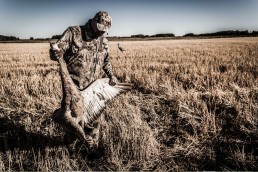Public Land: Finding Your Next Hunting Spot
SHARE THIS POST
It is no secret that access is one of the major deterrents to participation in hunting, fishing and other outdoor recreational pursuits. If you or someone you know falls into this category, public lands are the answer to your dilemma.
As a taxpayer, you are a stakeholder in large quantities of wild lands. Millions of acres across the nation are available to public hunting, fishing, hiking and general enjoyment.
Hunters are among the top land “users” in the nation who raise their voices about the lack of available access to hunting grounds. Private lands become more difficult to access by the day; Hunters must expect to pay large trespass fees to gain access to the best private land-hunting areas. However, public hunting lands are plentiful in our great country and access, in most cases, is free. What one lacks in dollars, one can partially make up by doing homework—applying a little reconnaissance on the ground. Finding public lands to hunt on are not as difficult as you might think. Here are some tips to help you get started.
State lands
Every state has park and wildlife lands individuals can hunt on. Quantities and varieties of these lands vary from state to state. Some are open to the public for specific uses; others are open for many types of recreation.
One of the best places to start your search for public lands is with your state conservation agency. If you do not know the website, simply Google it for state conservation agencies.
My home state of Missouri has over 1,000 parcels of land owned by the Missouri Department of Conservation. These range from parcels of only a few acres, to vast areas comprising 30,000 acres or more. Dozens of them lie within a 100-mile radius of my Ozark home. Many are near urban areas as well.
We are very fortunate in the state of Missouri. Citizens pay a 1/8th of a 1 percent sales tax to support conservation. Generated monies help support programs and properties for a vast array of hunting opportunities. Numerous Wildlife Management Areas (WMAs) exist in every county of the state. Hunting opportunities abound and specially managed hunts provide extra opportunities on WMAs and state parks.
Are you enjoying this post?
You can be among the first to get the latest info on where to go, what to use and how to use it!
County properties
Often overlooked by outdoor enthusiasts, county parks offer some outstanding outdoor recreation opportunities, including fishing and specially regulated hunting seasons, in some cases. Google county parks and recreation for your county or counties you are interested in. Many counties in Missouri that surround urban areas offer special deer control hunts.
A trip to your county courthouse can provide an invaluable tool: a county plat book. The plat book lists every piece of property in the county and the owner. You may be surprised to find out how many pieces of property your county owns. Many are open to hunting and often underutilized because of lack of public knowledge about the areas. Counties with up-to-date computer systems offer plat books online.
Federal lands
Federal lands comprise the largest acreage of lands available to the general public. There are federally owned lands in every state with federal ownership in states ranging from 0.3 percent in some, and up to 84 percent in states like Nevada. These holdings amount to millions of acres, offering outstanding hunting, fishing, hiking, camping, canoeing and boating opportunities.
The four main land management agencies administer vast areas. The Bureau of Land Management controls 248 million acres, the U.S. Forest Service 193 million acres, the U.S. Fish and Wildlife Service 89 million acres and the National Park Service manages 80 million acres. Millions more are managed by the U.S. Army Corps of Engineers and the Department of Defense.
Online resources
Recreation.gov provides information on hunting, fishing and other outdoor recreation opportunities at federal recreation areas. Mytopo.com offers maps for practically every public land area in every state; private companies also offer maps and programs associated with public lands. In today’s computer age, information about public lands and hunting opportunities are only a click away.
There is no reason for any American citizen to be deprived of hunting opportunities. Millions of acres are available and they belong to citizens. Many conservation and park agencies offer outdoors recreation programs to get the public involved in utilizing the public hunting lands. Many conservation organizations like Ducks Unlimited and the National Wild Turkey Federation offer programs. Finding programs and available public lands are only a few clicks away.
Hunters are crowded because they choose to be crowded by default—they simply avoid homework. There are 12.5 million hunters in the United States, roughly seven percent of the population. The U.S. Forest Service alone administers 192 million acres, all open to public hunting. That amounts to 1.5 million acres per hunter. Toss in all the other public lands and you discover you have a mind-boggling abundance of public lands to hunt. Also, remember that 60 percent of the nation’s wildlife lives on your public lands.
MWO
SHARE THIS POST
Did you enjoy this post?
You can be among the first to get the latest info on where to go, what to use and how to use it!
Bill Cooper
An inductee to the National Fresh Water Fishing Hall of Fame, Bill Cooper, from the Missouri Ozarks, has written over 4,000 articles on outdoor subjects. You can hear him on Wild at Heart Outdoor radio at espn1073.com.




